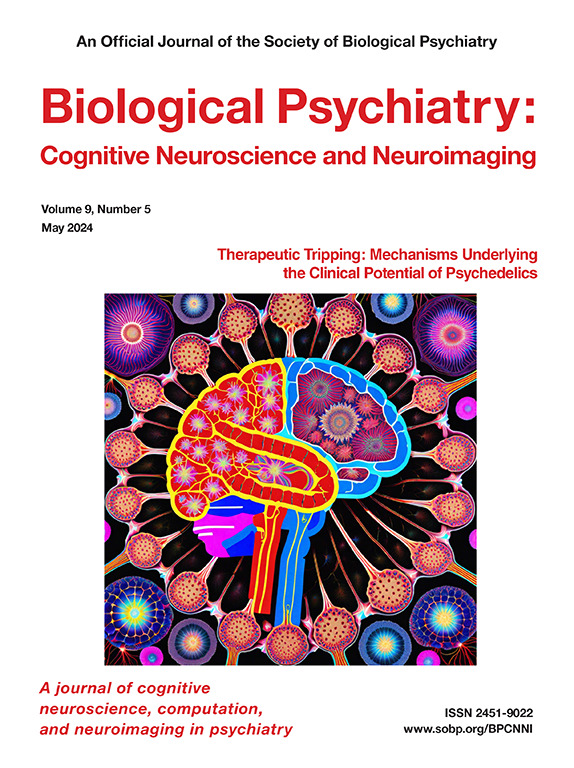Mapping Neuroinflammation With Diffusion-Weighted Magnetic Resonance Imaging: A Randomized Crossover Study
IF 4.8
2区 医学
Q1 NEUROSCIENCES
Biological Psychiatry-Cognitive Neuroscience and Neuroimaging
Pub Date : 2025-09-01
DOI:10.1016/j.bpsc.2025.05.002
引用次数: 0
Abstract
Background
The pathophysiology of neuroinflammation in psychiatric conditions remains poorly understood, highlighting the need for noninvasive tools that can measure neuroinflammation in vivo. We explored advanced diffusion-weighted magnetic resonance imaging (MRI) techniques for detection of low-level neuroinflammation induced by typhoid vaccine, with potential applications to psychiatric disorders.
Methods
Twenty healthy volunteers (10 males; median age 34, range 18–44 years) participated in a randomized, placebo-controlled, crossover design study. Participants underwent MRI before and after receiving placebo or vaccine in alternating sessions, separated by a washout period. Diffusion tensor (multishell and single shell), diffusion kurtosis, and neurite orientation dispersion and density imaging parameter maps were generated. Probabilistic tractography investigated differences in tract volume, fractional anisotropy, and mean diffusivity (MD) of the tracts. Thirteen tracts and 15 regions were analyzed using a region-of-interest (ROI) approach entered into linear mixed models to evaluate treatment effects.
Results
A treatment effect was observed on white matter tracts derived from XTRACT, with a global reduction in MD (p = .040). White matter tracts of interest showed increased axial kurtosis (p < .001) while gray matter ROIs demonstrated increased mean and radial kurtosis (both ps = .038). Additionally, several correlations were found between the inflammatory marker interleukin 6 and diffusion parameters.
Conclusions
Our findings demonstrate that diffusion-weighted MRI may be sensitive to inflammation-induced microstructural changes in the brain. Future studies should integrate complementary techniques and clinical assessments to deepen our understanding of inflammatory pathophysiology and its implications for health outcomes in clinical populations.
用弥散加权MRI映射神经炎症:随机交叉研究。
背景:精神疾病中神经炎症的病理生理学仍然知之甚少,这突出了对非侵入性工具的需求,这些工具可以在体内测量神经炎症。我们探索了先进的弥散加权MRI技术来检测伤寒疫苗引起的低水平神经炎症,并有可能应用于精神疾病。方法:20名健康志愿者(10名男性,中位年龄34岁,年龄范围18-44岁)参与了一项随机、安慰剂对照、交叉设计研究。参与者在接受安慰剂或疫苗接种前后交替进行MRI检查,间隔一段洗脱期。生成扩散张量(多壳和单壳)、扩散峰度、神经突取向密度和弥散成像参数图。概率性肛管造影研究了肛管体积、分数各向异性(FA)和平均扩散率(MD)的差异。13个地区和15个地区使用兴趣区域方法进入线性混合模型来评估治疗效果。结果:在XTRACT衍生的白质束上观察到治疗效果,MD总体减少(p= 0.040)。结论:我们的研究结果表明,弥散加权MRI可能对炎症引起的大脑微结构变化敏感。未来的研究应整合互补技术和临床评估,以加深我们对炎症病理生理学及其对临床人群健康结果的影响的理解。
本文章由计算机程序翻译,如有差异,请以英文原文为准。
求助全文
约1分钟内获得全文
求助全文
来源期刊

Biological Psychiatry-Cognitive Neuroscience and Neuroimaging
Neuroscience-Biological Psychiatry
CiteScore
10.40
自引率
1.70%
发文量
247
审稿时长
30 days
期刊介绍:
Biological Psychiatry: Cognitive Neuroscience and Neuroimaging is an official journal of the Society for Biological Psychiatry, whose purpose is to promote excellence in scientific research and education in fields that investigate the nature, causes, mechanisms, and treatments of disorders of thought, emotion, or behavior. In accord with this mission, this peer-reviewed, rapid-publication, international journal focuses on studies using the tools and constructs of cognitive neuroscience, including the full range of non-invasive neuroimaging and human extra- and intracranial physiological recording methodologies. It publishes both basic and clinical studies, including those that incorporate genetic data, pharmacological challenges, and computational modeling approaches. The journal publishes novel results of original research which represent an important new lead or significant impact on the field. Reviews and commentaries that focus on topics of current research and interest are also encouraged.
 求助内容:
求助内容: 应助结果提醒方式:
应助结果提醒方式:


